Recycling Waste Agricultural Nets as Cement Composites
Abstract
1. Introduction
2. Materials and Methods
2.1. Materials
2.2. Testing Procedures
3. Research Results and Analysis
4. Conclusions
Author Contributions
Funding
Institutional Review Board Statement
Informed Consent Statement
Data Availability Statement
Acknowledgments
Conflicts of Interest
References
- O‘Brien, P.K. Agriculture, and the industrial revolution. Econ. Hist. Rev. 1977, 30, 166–181. [Google Scholar] [CrossRef]
- Allen, R. Agriculture during the industrial revolution. Econ. Hist. Br. Since 1994, 1700, 96–123. [Google Scholar]
- Himesh, S.; Rao, E.P.; Gouda, K.C.; Ramesh, K.V.; Rakesh, V.; Mohapatra, G.N.; Ajilesh, P. Digital revolution and Big Data: A new revolution in agriculture. CABI Rev. 2018, 2018, 1–7. [Google Scholar] [CrossRef]
- Tilman, D. Global environmental impacts of agricultural expansion: The need for sustainable and efficient practices. Proc. Natl. Acad. Sci. USA 1999, 96, 5995–6000. [Google Scholar] [CrossRef] [PubMed]
- Lorenz, K.; Lal, R. Environmental impact of organic agriculture. Adv. Agron. 2016, 139, 99–152. [Google Scholar]
- Clark, M.; Tilman, D. Comparative analysis of environmental impacts of agricultural production systems, agricultural input efficiency, and food choice. Environ. Res. Lett. 2017, 12, 064016. [Google Scholar] [CrossRef]
- Di, H.J.; Cameron, K.C. Reducing environmental impacts of agriculture by using a fine particle suspension nitrification inhibitor to decrease nitrate leaching from grazed pastures. Agric. Ecosyst. Environ. 2005, 109, 202–212. [Google Scholar] [CrossRef]
- Liu, Q.; Piao, S.; Janssens, I.A.; Fu, Y.; Peng, S.; Lian, X.U.; Wang, T. Extension of the growing season increases vegetation exposure to frost. Nat. Commun. 2018, 9, 426. [Google Scholar] [CrossRef]
- Maraveas, C. Environmental sustainability of plastic in agriculture. Agriculture 2020, 10, 310. [Google Scholar] [CrossRef]
- Maraveas, C.; Bayer, I.S.; Bartzanas, T. 4D printing: Perspectives for the production of sustainable plastics for agriculture. Biotechnol. Adv. 2022, 54, 107785. [Google Scholar] [CrossRef]
- Briassoulis, D.A.; Mistriotis, A.; Eleftherakis, D. Mechanical behaviour and properties of agricultural nets. Part II: Analysis of the performance of the main categories of agricultural nets. Polym. Test. 2007, 26, 970–984. [Google Scholar] [CrossRef]
- Briassoulis, D.; Mistriotis, A. Integrated structural design methodology for agricultural protecting structures covered with nets. Biosyst. Eng. 2010, 105, 205–220. [Google Scholar] [CrossRef]
- Castellano, S.; Russo, G.; Briassoulis, D. Plastic Nets in Agriculture: A General Review of Types and Applications. Appl. Eng. Agric. 2013, 24, 799–808. [Google Scholar] [CrossRef]
- Dib, H.; Sauphanor, B.; Capowiez, Y. Effect of codling moth exclusion nets on the rosy apple aphid, Dysaphisplantaginea, and its control by natural enemies. Crop. Prot. 2010, 29, 1502–1513. [Google Scholar] [CrossRef]
- Živković, P.; Lemic, D.; Samu, F.; Kos, T.; Barić, B. Spider communities affected by exclusion nets. Appl. Ecol. Environ. Res. 2019, 17, 879–887. [Google Scholar] [CrossRef]
- Maas, B.; Heath, S.; Grass, I.; Cassano, C.; Classen, A.; Faria, D.; Gras, P.; Williams-Guillén, K.; Johnson, M.; Karp, D.S.; et al. Experimental field exclosure of birds and bats in agricultural systems—Methodological insights, potential improvements, and cost-benefit trade-offs. Basic Appl. Ecol. 2019, 35, 1–12. [Google Scholar] [CrossRef]
- Dáder, B.; Legarrea, S.; Moreno, A.; Plaza, M.; Fereres, A. Control of insect vectors and plant viruses in protected crops by novel pyrethroid-treated. Pest. Manag. Sci. 2014, 71, 1397–1406. [Google Scholar] [CrossRef] [PubMed]
- Taylor, R.K. Technical Notes: Effect of Net-wrapping on Large Round Baler Capacity. Appl. Eng. Agric. 1995, 11, 229–230. [Google Scholar] [CrossRef]
- Kowalik, I.; Zawieja, B.; Rybacki, P.; Krzyżaniak, K. Evaluation of the Quality and Possible Use of a New Generation of Agricultural Nets for Packing Bulk Materials in Terms of the Aspect of Reducing the Environmental Burden. Agriculture 2023, 13, 367. [Google Scholar] [CrossRef]
- Castellano, S.; Di Palma, A.; Germinara, G.S.; Lippolis, M.; Starace, G.; Scarascia-mugnozza, G. Experimental Nets for a Protection System against the Vectors of Xylella fastidiosa. Agriculture 2019, 9, 32. [Google Scholar] [CrossRef]
- Mukherjee, A.; Knoch, S.; Tavares, J.R. Use of bio-based polymers in agricultural exclusion nets: A perspective. Biosyst. Eng. 2019, 180, 121–145. [Google Scholar] [CrossRef]
- De Simone, S.; Lombardi, F.A.; Paladini, F.; Starace, G.; Sannino, A.; Pollini, M. Development of antibacterial silver treatments on HDPE nets for agriculture. J. Appl. Polym. Sci. 2015, 132, 1–7. [Google Scholar] [CrossRef]
- Maraveas, C. The Sustainability of Plastic Nets in Agriculture. Sustainability 2020, 12, 3625. [Google Scholar] [CrossRef]
- Twardowski, P. Nets or string? Top Agrar Polska 2010, 5, 118–120. (In Polish) [Google Scholar]
- Yang, G.; Guo, Z.; Ji, H.; Sheng, J.; Chen, L. Application of insect-proof nets in pesticide-free rice creates an altered microclimate and differential agronomic performance. Peer J. 2018, 6, e6135. [Google Scholar] [CrossRef]
- Narayan, R. Polymeric Materials from Agricultural Feedstocks; ACS Symposium Series; American Chemical Society: Washington, DC, USA, 1994; pp. 1–27. [Google Scholar]
- Statuto, D.; Abdel-ghany, A.M.; Starace, G.; Arrigoni, P.; Picuno, P. Comparison of the efficiency of plastic nets for shading greenhouse in different climates. In Proceedings of the International Mid-Term Conference of the Italian Association of Agricultural Engineering, Matera, Italy, 12–13 September 2019. [Google Scholar]
- Wang, X.; Ding, B.; Sun, G.; Wang, M.; Yu, J. Progress in Materials Science Electro-spinning/netting: A strategy for the fabrication of three-dimensional polymer nano-fiber/nets. Prog. Mater. Sci. 2013, 58, 1173–1243. [Google Scholar] [CrossRef]
- Blanco, I.; Loisi, R.V.; Sica, C.; Schettini, E.; Vox, G. Resources, Conservation & Recycling Agricultural plastic waste mapping using GIS. A case study in Italy. Resour. Conserv. Recycl. 2018, 137, 229–242. [Google Scholar]
- Abdel-Ghany, A.M.; Al-Helal, I.M. Modeling Approach for Determining Equivalent Optical Constants of Plastic Shading Nets under. Adv. Mater. Sci. Eng. 2012, 2012, 158067. [Google Scholar] [CrossRef]
- Hatti-kaul, R.; Nilsson, L.J.; Zhang, B.; Rehnberg, N.; Lundmark, S. Review Designing Biobased Recyclable Polymers for Plastics. Trends Biotechnol. 2020, 38, 50–67. [Google Scholar] [CrossRef]
- Qaidi, S.; Najm, H.M.; Abed, S.M.; Özkılıç, Y.O.; Al Dughaishi, H. Concrete containing waste glass as an environmentally friendly aggregate: A review on fresh and mechanical characteristics. Materials 2022, 15, 6222. [Google Scholar] [CrossRef]
- Bascetin, A.; Adiguzel, D.; Eker, H.; Odabas, E. Effects of puzzolanic materials in surface paste disposal by pilot-scale tests: Observation of physical changes. Int. J. Environ. Sci. Technol. 2021, 18, 949–964. [Google Scholar] [CrossRef]
- Eker, H.; Bascetin, A. The study of strength behaviour of zeolite in cemented paste backfill. Geomech. Eng. 2022, 29, 421–434. [Google Scholar]
- Jin, R.; Chen, Q. Investigation of concrete recycling in the U.S. construction industry. Procedia Eng. 2015, 118, 894–901. [Google Scholar] [CrossRef]
- Pangsy-Kania, S. System zarządzania rozwojem w Polsce i rola w nim dokumentów strategicznych. Stud. Z Polityki Publicznej 2015, 7, 120–137. [Google Scholar] [CrossRef]
- Małaszkiewicz, D.; Pawluczuk, E. Influence of recycledaggregate on selectedtechnicalproperties of concrete, Prace Naukowe Instytutu Budownictwa Politechniki Wrocławskiej. Stud. Mater. 2006, 87, 405–410. [Google Scholar]
- Hare, B.; Golebiowska, I. The future of concrete with recycled concrete aggregate. Inż. Ap. Chem. 2014, 53, 390–392. [Google Scholar]
- Anink, D.; Boonstra, C.; Mak, J. Handbook of Sustainable Building, An Environmental Preference Method for Selection of Materials for Use in Construction and Refurbishment; Chapman Publication: London, UK, 1996. [Google Scholar]
- Ajdukiewicz, A.; Kliszczewicz, A. Ad hoc and rheological properties of structural concretes on recycled aggregates. Zesz. Nauk. Politech. Rzeszowskiej. Bud. Inżynieria Sr. 2012, 3, 173–180. [Google Scholar]
- Ahn, T.H.; Kishi, T. Crack self-healing behaviour of cementitious composites incorporating various mineral admixtures. J. Adv. Concr. Technol. 2010, 8, 171–186. [Google Scholar] [CrossRef]
- Jevtić, D.; Zakić, D.; Savić, A. Achieving sustainability of concrete by recycling of solid waste materials. Mech. Test. Diagn. 2012, 2, 22–39. [Google Scholar]
- Hansen, T.C.; Narud, H. Strength of recycled concrete made from crushed concrete coarse aggregate. Concr. Int.-Des. Constr. 2003, 5, 35–48. [Google Scholar]
- Rao, A.; Jha, K.N.; Misra, S. Use of aggregates from recycled construction and demolition waste in concrete. Res. Conserv. Recycl. 2007, 50, 71–81. [Google Scholar] [CrossRef]
- Best Practice Guide for the Use of Recycled Aggregates in New Concrete; CCANZ Technical Report; Cement and Concrete Association: Wellington, New Zealand, 2014.
- Senthamarai, R.M.; Devadas, A.; Manoharan, P.; Gobinath, D. Concrete made from ceramic industry waste: Durability propertis. Constr. Build. Mater. 2011, 25, 2413–2419. [Google Scholar] [CrossRef]
- De Brito, J.; Pereira, J.R. Mechanical behaviour of non-structural concrete made with recycled ceramic aggregates. Cem. Concr. Compos. 2005, 27, 429–433. [Google Scholar] [CrossRef]
- Pacheco-Torgal, F.; Jalali, S. Reusing ceramic wastes in concrete. Constr. Build. Mater. 2010, 24, 832–838. [Google Scholar] [CrossRef]
- Debieb, A.; Farid, K.; Kenai, S. The use of coarse and fine crushed bricks as aggregate in concrete. Constr. Build. Mater. 2008, 22, 886–893. [Google Scholar] [CrossRef]
- Devenny, A.; Khalaf, F.M. Use of crushed brick as coarse aggregate in concrete. Mason. Int. 1999, 12, 81–84. [Google Scholar]
- Khalaf, F.M.; DeVenny, A.S. Recycling of demolished masonry rubble as coarse aggregate in concrete: Review. J. Mater. Civ. Eng. 2004, 16, 331–340. [Google Scholar] [CrossRef]
- Khalloo, A.R. Properties of concrete using crushed clinker brick as coarse aggregate. ACI Mater. J. 1994, 91, 401–407. [Google Scholar]
- Khatie, M. Properties of concrete incorporating fine recycled aggregate. Cem. Concr. Res. 2005, 35, 763–769. [Google Scholar] [CrossRef]
- Guerra, I. Eco-efficient concrete: The effects of using recycled ceramic material from sanitary installations on the mechanical properties of concrete. Waste Manag. 2009, 29, 643–646. [Google Scholar] [CrossRef]
- Medina, C.; Frias, M.; De Rojas, M.I. Microstructure and properties of recycled concretes using ceramic sanitary ware industry waste as coarse aggregate. Constr. Build. Mater. 2012, 31, 112–118. [Google Scholar] [CrossRef]
- Halicka, A.; Ogrodnik, P.; Zegardło, B. Using ceramic sanitary ware waste as concrete aggregate. Constr. Build. Mater. 2014, 48, 295–305. [Google Scholar] [CrossRef]
- Zegardło, B.; Szeląg, M.; Ogrodnik, P. Ultra-high strength concrete made with recycled aggregate from sanitary ceramic wastes—The method of production and the interfacial transition zone. Constr. Build. Mater. 2016, 122, 736–742. [Google Scholar] [CrossRef]
- Zegardło, B.; Szeląg, M.; Ogrodnik, P. Concrete resistant to spalling made with recycled aggregate from sanitary ceramic wastes—Effect of moisture and porosity on destructive processes occurring in fire conditions. Constr. Build. Mater. 2018, 173, 58–68. [Google Scholar] [CrossRef]
- Ogrodnik, P.; Zegardło, B.; Radzikowska, M. Use of post-production sanitary ceramic waste as a filler for cementitious composites with high chemical resistance. Chem. Ind. 2017, 96, 1100–1104. [Google Scholar]
- Ogrodnik, P.; Zegardło, B.; Szeląg, M. The use of heat-resistant concrete made with ceramic sanitary ware waste for a thermal energy storage. Appl. Sci. 2017, 7, 1303. [Google Scholar] [CrossRef]
- Zegardło, B.; Brzyski, P.; Rymuza, K.; Bombik, A. Analysis of the Effects of Aggressive Environments Simulating Municipal Sewage on Recycled Concretes Based on Selected Ceramic Waste. Materials 2018, 11, 2565. [Google Scholar] [CrossRef] [PubMed]
- Ahmad, J.; Zhou, Z.; Majdi, A.; Alqurashi, M.; Deifalla, A.F. Overview of Concrete Performance Made with Waste Rubber Tires: A Step toward Sustainable Concrete. Materials 2022, 15, 5518. [Google Scholar] [CrossRef]
- Fashandi, H.; Pakravan, H.R.; Latifi, M. Application of modified carpet waste cuttings for production of eco-efficient lightweight concrete. Constr. Build. Mater. 2019, 198, 629–637. [Google Scholar] [CrossRef]
- Şahin, D.; Çullu, M.; Eker, H. The effect of different fineness values of AfşinElbistan fly ash on permeability in concrete. Challenge 2020, 6, 73–83. [Google Scholar]
- Adiguzel, D.; Tuylu, S.; Eker, H. Utilization of tailings in concrete products: A review. Constr. Build. Mater. 2022, 360, 129574–129577. [Google Scholar] [CrossRef]
- Zegardło, B.; Maraveas, C.; Kaleszko, S.; Bombik, A. Composites Containing Felt Wastes from the Automotive Industry. Appl. Sci. 2023, 13, 2375. [Google Scholar] [CrossRef]
- Xotta, G.; Mazucco, G.; Salomoni, V.A.; Majorana, C.E.; Willam, K.J. Composite behavior of concrete materials under high temperatures. Int. J. Solids Struct. 2015, 65, 86–99. [Google Scholar] [CrossRef]
- Ming-Xiang, X.; Richard, J.Y. Mechanical behaviour of ultra-high strength concrete at elevated temperatures and fire resistance of ultra-high strength concrete filled steel tubes. Mater. Des. 2016, 104, 414–427. [Google Scholar] [CrossRef]
- Kun Dong, H. Development of bond strength model for CFRP-to-concrete joints at high temperatures. Composites 2016, 95, 264–271. [Google Scholar] [CrossRef]
- Kodur, V.K.R.; Shaky, A.M. Factors governing the shear response of prestressed concrete hollowcore slabs under fire conditions. Fire Saf. J. 2017, 88, 67–88. [Google Scholar] [CrossRef]
- Ogrodnik, P.; Zegardło, B.; Halicka, A. Preliminary analysis of the possibility of using waste sanitary ceramics in the function of aggregate for concretes working in high temperature conditions. Bezpieczeństwo Tech. Pożarnicza 2012, 1, 49–56. [Google Scholar]
- Bieda, W.; Laurecka, H. Fireproof Masses, Concretes and Prefabricated Elements; WydawnictwoŚląsk: Katowice, Poland, 1981. [Google Scholar]
- Chan, G.F.; Peng, M. Anson, Comparison between high-strength concrete and normal-strength concrete subjected to high temperature. Mater. Struct. 1996, 29, 616–619. [Google Scholar] [CrossRef]
- Chen, Q. The Influence of High Temperature on Explosive Spalling Behavior and Mechanical Properties of Reactive Powder Concrete. Ph.D. Thesis, Beijing Jiaotong University, Beijing, China, 2010. [Google Scholar]
- Harmarthy, T.Z. Effect of Moisture on the Fire Endurance of Building Elements. ASTM Spec. Tech. Publ. 1965, 385, 74–95. [Google Scholar]
- Baoant, Z.P. Analysis of pore pressure, thermal stresses and fracture in rapidly heated concrete. In Proceedings of the International Workshop on Fire Performance of High-Strength Concrete (NIST Special Publication 919), Gaithersburg, MD, USA, 13–14 February 1997; pp. 155–164. [Google Scholar]
- Kalifa, P.; Menneteau, F.D. Quenard, Spalling and pore pressure in HPC at high temperature. Cem. Concr. Res. 2000, 30, 1915–1927. [Google Scholar] [CrossRef]
- Ishikawa, S. Explosion preventive structure of high-strength concrete method. Mater. Struct. 1996, 29, 616–619. [Google Scholar]
- Sarvaranta, L.; Mikkola, E. Fibremotar composites under fire conditions: Effects of ageing and moisture content of specimens. Mater. Struct. 1994, 27, 532–538. [Google Scholar] [CrossRef]
- Doherty, P.; Ali, F.; Nadjai, A.; Choi, S. Explosive spalling of concrete columns with steel and polypropylene fibres subjected to severe fire. J. Struct. Fire Eng. 2012, 3, 95–104. [Google Scholar] [CrossRef]
- Bilodeau, A.; Kodur, V.K.R.; Hoff, G.C. Optimization of the type and amount of polypropylene fibres for preventing the spalling of lightweight concrete subjected to hydrocarbon fire. Cem. Concr. Compos. 2004, 26, 163–174. [Google Scholar] [CrossRef]
- Momose, H.; Sakuramoto, F.; Yanagita, K. Experimental Study on Fire Resistance of Ultra-high Strength Concrete with Design Strength of 150N/mm2 mixed with Polypropylene Fiber. Jpn. Concr. Inst. 2003, 25, 995–1000. [Google Scholar]
- Abu-Saleem, M.; Zhuge, Y.; Hassanli, R.; Ellis, M.; Rahman, M.; Levett, P. Evaluation of concrete performance with different types of recycled plastic waste for kerb application. Constr. Build. Mater. 2021, 293, 123477. [Google Scholar] [CrossRef]
- Bahij, S.; Omary, S.; Feugeas, F.; Faqiri, A. Fresh and hardened properties of concrete containing different forms of plastic waste–A review. Waste Manag. 2020, 113, 157–175. [Google Scholar] [CrossRef] [PubMed]
- Thosar, C.P.; Husain, D.M. Reuse of plastic waste as replacement of sand in concrete. Int. J. Innov. Res. Sci. Eng. Technol. 2017, 6, 789–794. [Google Scholar]
- Askar, M.K.; Askar, L.K.; Al-Kamaki, Y.S.S.; Ferhadi, R. Effects of chopped CFRP fiber on mechanical properties of concrete. Heliyon 2023, 9, e13832. [Google Scholar] [CrossRef]
- Marthong, C.; Marthong, S. An experimental study on the effect of PET fibers on the behavior of exterior RC beam-column connection subjected to reversed cyclic loading. Structures 2016, 5, 175–185. [Google Scholar] [CrossRef]
- Al-Hadithi, A.I.; Abbas, M.A. The effects of adding waste plastic fibers on the mechanical properties and shear strength of reinforced concrete beams. Iraqi J. Civ. Eng. 2018, 12, 110–124. [Google Scholar] [CrossRef]
- Khatab, H.R.; Mohammed, S.J.; Hameed, L.A. Mechanical Properties of Concrete Contain Waste Fibers of Plastic Straps. In IOP Conference Series: Materials Science and Engineering; IOP Publishing: Bristol, UK, 2019. [Google Scholar]
- Pešić, N.; Živanović, S.; Garcia, R.; Papastergiou, P. Mechanical properties of concrete reinforced with recycled HDPE plastic fibres. Constr. Build. Mater. 2016, 115, 362–370. [Google Scholar] [CrossRef]
- Bhogayata, A.C.; Arora, N.K. Fresh and strength properties of concrete reinforced with metalized plastic waste fibers. Constr. Build. Mater. 2017, 146, 455–463. [Google Scholar] [CrossRef]
- Mohammadhosseini, H.; Alyousef, R.; Lim, N.H.A.S.; Tahir, M.M.; Alabduljabbar, H.; Mohamed, A.M.; Samadi, M. Waste metalized film food packaging as low cost and ecofriendly fibrous materials in the production of sustainable and green concrete composites. J. Clean. Prod. 2020, 258, 120726. [Google Scholar] [CrossRef]
- Dawood, A.O.; Al-Khazraji, H.; Falih, R.S. Physical and mechanical properties of concrete containing PET wastes as a partial replacement for fine aggregates. Case Stud. Constr. Mater. 2021, 14, e00482. [Google Scholar] [CrossRef]
- Skominas, R.; Zvinakevičius, L.; Gurskis, V.; Šadzevičius, R. Evaluation of suitability to use plastic waste in concrete production. In Proceedings of the International Scientific Conference Rural Development, Akademija, Litwa, 23–24 November 2017; Aleksandras Stulginskis University: Akademija, Lithuania, 2017; pp. 428–432. [Google Scholar]
- Hama, S.M.; Hilal, N.N. 5-Fresh properties of concrete containing plastic aggregate. In Use of Recycled Plastics in Eco-Efficient Concrete; Pacheco-Torgal, F., Khatib, J., Colangelo, F., Tuladhar, R., Eds.; Woodhead Publishing: Cambridge, UK, 2019; pp. 85–114. [Google Scholar]
- Rai, B.; Rushad, S.T.; Kr, B.; Duggal, S. Study of waste plastic mix concrete with plasticizer. ISRN Civ. Eng. 2012, 2012, 469272. [Google Scholar] [CrossRef]
- Saikia, N.; de Brito, J. Mechanical properties and abrasion behaviour of concrete containing shredded PET bottle waste as a partial substitution of natural aggregate. Constr. Build. Mater. 2014, 52, 236–244. [Google Scholar] [CrossRef]
- Silva, R.V.; de Brito, J.; Saikia, N. Influence of curing conditions on the durability-related performance of concrete made with selected plastic waste aggregates. Cem. Concr. Compos. 2013, 35, 23–31. [Google Scholar] [CrossRef]
- Kumar, K.S.; Baskar, K. Recycling of E-plastic waste as a construction material in developing countries. J. Mater. Cycles Waste Manag. 2015, 17, 718–724. [Google Scholar] [CrossRef]
- Ismail, Z.Z.; Al-Hashmi, E.A. Use of waste plastic in concrete mixture as aggregate replacement. Waste Manag. 2008, 28, 2041–2047. [Google Scholar] [CrossRef]
- Meena, A.; Surendranath, A.; Ramana, P.V. Assessment of mechanical properties and workability for polyethylene terephthalate fiber reinforced concrete. Mater. Today Proc. 2021, V50, 2307–2314. [Google Scholar] [CrossRef]
- Alani, A.H.; Bunnori, N.M.; Noaman, A.T.; Majid, T.A. Durability performance of a novel ultra-high-performance PET green concrete (UHPPGC). Constr. Build. Mater. 2019, 209, 395–405. [Google Scholar] [CrossRef]
- Kakooei, S.; Akil, H.M.; Jamshidi, M.; Rouhi, J. The effects of polypropylene fibers on the properties of reinforced concrete structures. Constr. Build. Mater. 2012, 27, 73–77. [Google Scholar] [CrossRef]
- Miraldo, S.; Lopes, S.; Pacheco-Torgal, F.; Lopes, A. Advantages and shortcomings of the utilization of recycled wastes as aggregates in structural concretes. Constr. Build. Mater. 2021, 298, 123729. [Google Scholar] [CrossRef]
- Belmokaddem, M.; Mahi, A.; Senhadji, Y.; Pekmezci, B.Y. Mechanical and physical properties and morphology of concrete containing plastic waste as aggregate. Constr. Build. Mater. 2020, 257, 119559. [Google Scholar] [CrossRef]
- Pereira, E.L.; de Oliveira Junior, A.L.; Fineza, A.G. Optimization of mechanical properties in concrete reinforced with fibers from solid urban wastes (PET bottles) for the production of ecological concrete. Constr. Build. Mater. 2017, 149, 837–848. [Google Scholar] [CrossRef]
- Albano, C.; Camacho, N.; Hernández, M.; Matheus, A.; Gutierrez, A. Influence of content and particle size of waste pet bottles on concrete behavior at different w/c ratios. Waste Manag. 2009, 29, 2707–2716. [Google Scholar] [CrossRef] [PubMed]
- Kotlarz, P. The use of waste plastics as synthetic fibers and aggregates in concrete—A review. Wobec 2023, 4, 12. (In Polish) [Google Scholar]
- Azhdarpour, A.M.; Nikoudel, M.R.; Taheri, M. The effect of using polyethylene terephthalate particles on physical and strength-related properties of concrete; a laboratory evaluation. Constr. Build. Mater. 2016, 109, 55–62. [Google Scholar] [CrossRef]
- Frigione, M. Recycling of PET bottles as fine aggregate in concrete. Waste Manag. 2010, 30, 1101–1106. [Google Scholar] [CrossRef]
- Askar, M.K.; Hassan, A.F.; Al-Kamaki, Y.S.S. Flexural and shear strengthening of reinforced concrete beams using FRP composites: A state of the art. Case Stud. Constr. Mater. 2022, 17, e01189. [Google Scholar] [CrossRef]
- Mohammadhosseini, H.; Yatim, J.M. Microstructure and residual properties of green concrete composites incorporating waste carpet fibers and palm oil fuel ash at elevated temperatures. J. Clean. Prod. 2017, 144, 8–21. [Google Scholar] [CrossRef]
- Girardi, F.; Giannuzzi, G.M.; Mazzei, D. Recycled additions for improving the thermal conductivity of concrete in preparing energy storage systems. Constr. Build. Mater. 2017, 135, 565–579. [Google Scholar] [CrossRef]
- Ozger, O.B.; Girard, F.; Giannuzzi, G.M. Effect of nylon fibres on mechanical and thermal properties of hardened concrete for energy storage systems. Mater. Des. 2013, 51, 989–997. [Google Scholar] [CrossRef]
- Mohammadhosseini, H.; Lim, N.H.; Sam, A. Effects of elevated temperatures on residual properties of concrete reinforced with waste polypropylene carpet fibres. Arab. J. Eng. 2018, 43, 1673–1686. [Google Scholar] [CrossRef]
- PN-C-89280:1986; Polyethylene—Testing. Polish Committee Standardisation: Warsaw, Poland, 1986.
- EN ISO 1183-2:2006; Plastics—Methods for Determining the Density of Plastics. Polish Committee Standardisation: Warsaw, Poland, 2006.
- EN ISO 1872-2:2008; Plastics—Polyethylene (PE) for Various Moulding Techniques—Part 2: Preparation of Tests and Determination of Properties. Polish Committee Standardisation: Warsaw, Poland, 2008.
- PN-C-04243:197; Plastics—Determination of Strength. Polish Committee Standardisation: Warsaw, Poland, 1972.
- ISO 11359-1:2023; Plastics—Teromomechanical analysis. International Organisation for Standardisation: Geneva, Shwitzerland, 2023.
- EN 196-3+A1:2009; Methods of Testing Cement—Part 3: Determination of Setting Times and Stability of Volume. Polish Committee Standardisation: Warsaw, Polan, 2009.
- EN 197-1:2012; Cement—Part 1: Composition, Requirements and Conformity Criteria for Cements for General Use. Polish Committee Standardisation: Warsaw, Poland, 2012.
- EN 196-6:2011; Methods of Testing Cement—Part 6: Determination of Degree of Grinding. Polish Committee Standardisation: Warsaw, Poland, 2011.
- EN 196-2:2006; Methods of Testing Cement—Part 2: Chemical analysis of cement. Polish Committee Standardisation: Warsaw, Poland, 2006.
- EN 1097-6:2013-11; Testing of Mechanical and Physical Properties of Aggregates—Part 6: Determination of Grain Density and Absorbability. Polish Committee Standardisation: Warsaw, Poland, 2013.
- EN 1097-3:2000; Testing of Mechanical and Physical Properties of Aggregates. Determination of Bulk Density and Coarseness, Annex B. Polish Committee Standardisation: Warsaw, Poland, 2000.
- EN ISO 10523:2012; Determination of pH. Polish Committee Standardisation: Warsaw, Poland, 2012.
- EN 934-2+A1:2012; Admixtures for Concrete, Mortar and Grout—Part 2: Concrete Admixtures—Definitions, Requirements, Conformity, Marking and Labelling. Polish Committee Standardisation: Warsaw, Poland, 2012.
- EN 933-1:2000; Testing of Geometrical Properties of Aggregates—Determination of Grain Composition—Method of Sieving. Polish Committee Standardisation: Warsaw, Poland, 2000.
- EN 12350-2:2011; Testing Fresh Concrete. Slump-Test. Polski Komitet Normalizacyjny: Warsaw, Poland, 2011.
- PN-EN 12390-7:2011; Testing Hardened Concrete. Density of Hardened Concrete. Polish Committee Standardisation: Warsaw, Poland, 2011.
- PN-EN 13755:2008; Natural Stone Test Methods. Determination of Water Absorption at Atmospheric Pressure. Polish Committee Standardisation: Warsaw, Poland, 2008.
- PN-EN 12390-5:2009; Testing Hardened Concrete. Flexural Strength of Test Specimens. Polish Committee Standardisation: Warsaw, Poland, 2009.
- PN-EN 12390-3:2011; Testing Hardened Concrete. Compressive Strength of Test Specimens. Polish Committee Standardisation: Warsaw, Poland, 2011.
- PN-EN 1991-1-2; Eurokod 1: Actions on structures, Part 1–2: Actions on Structures during Fire. Polish Committee Standardisation: Warsaw, Poland, 1991.
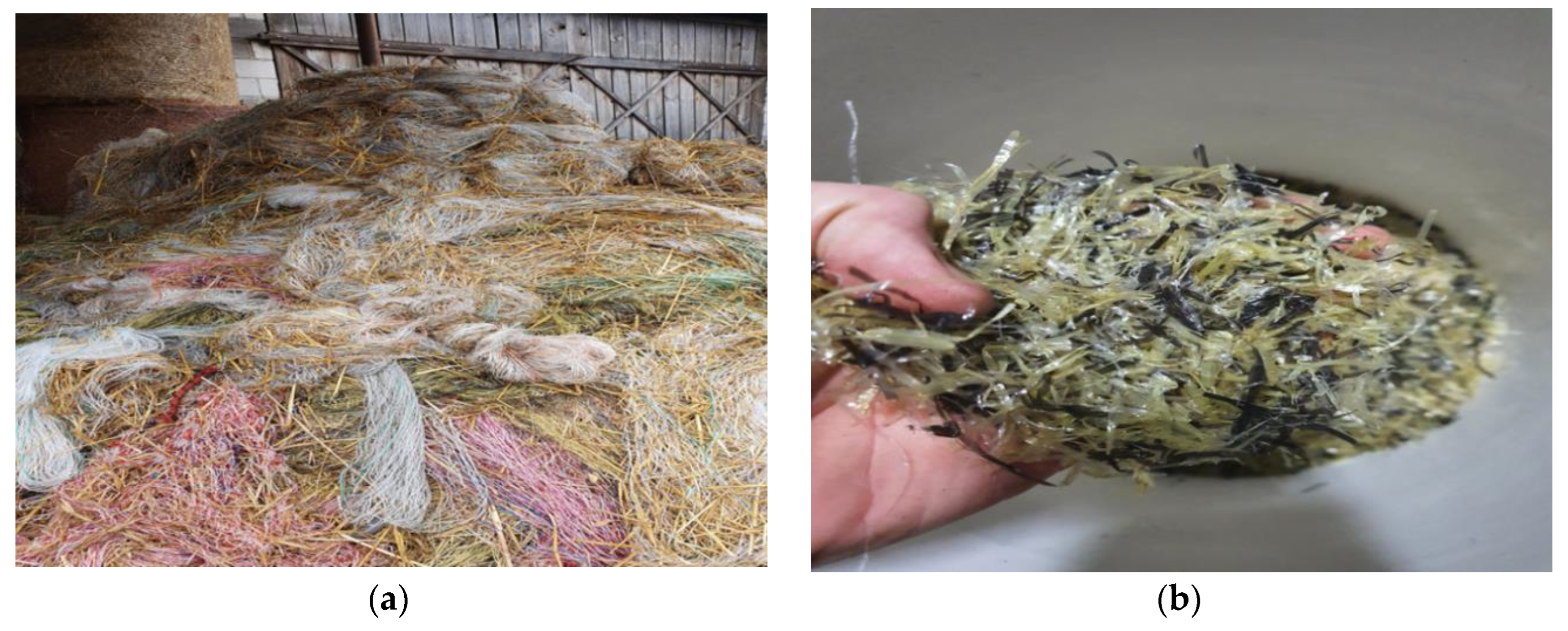

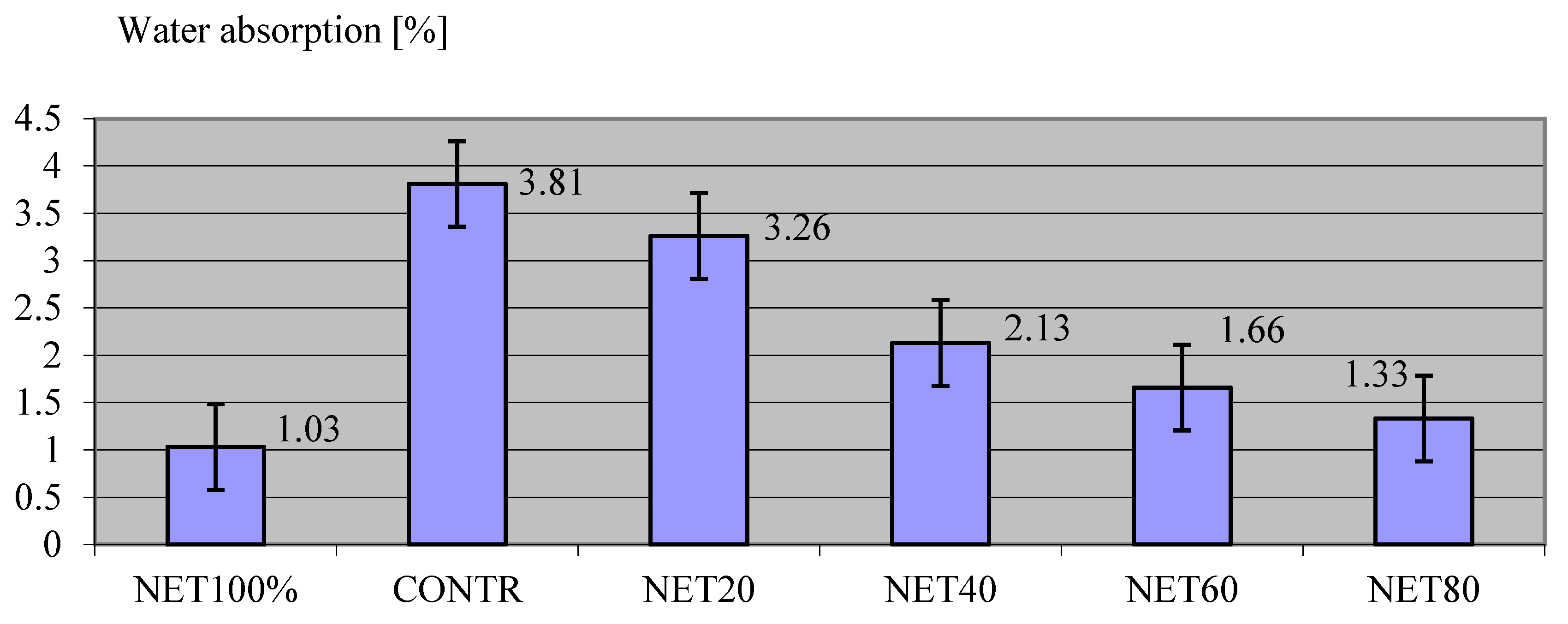
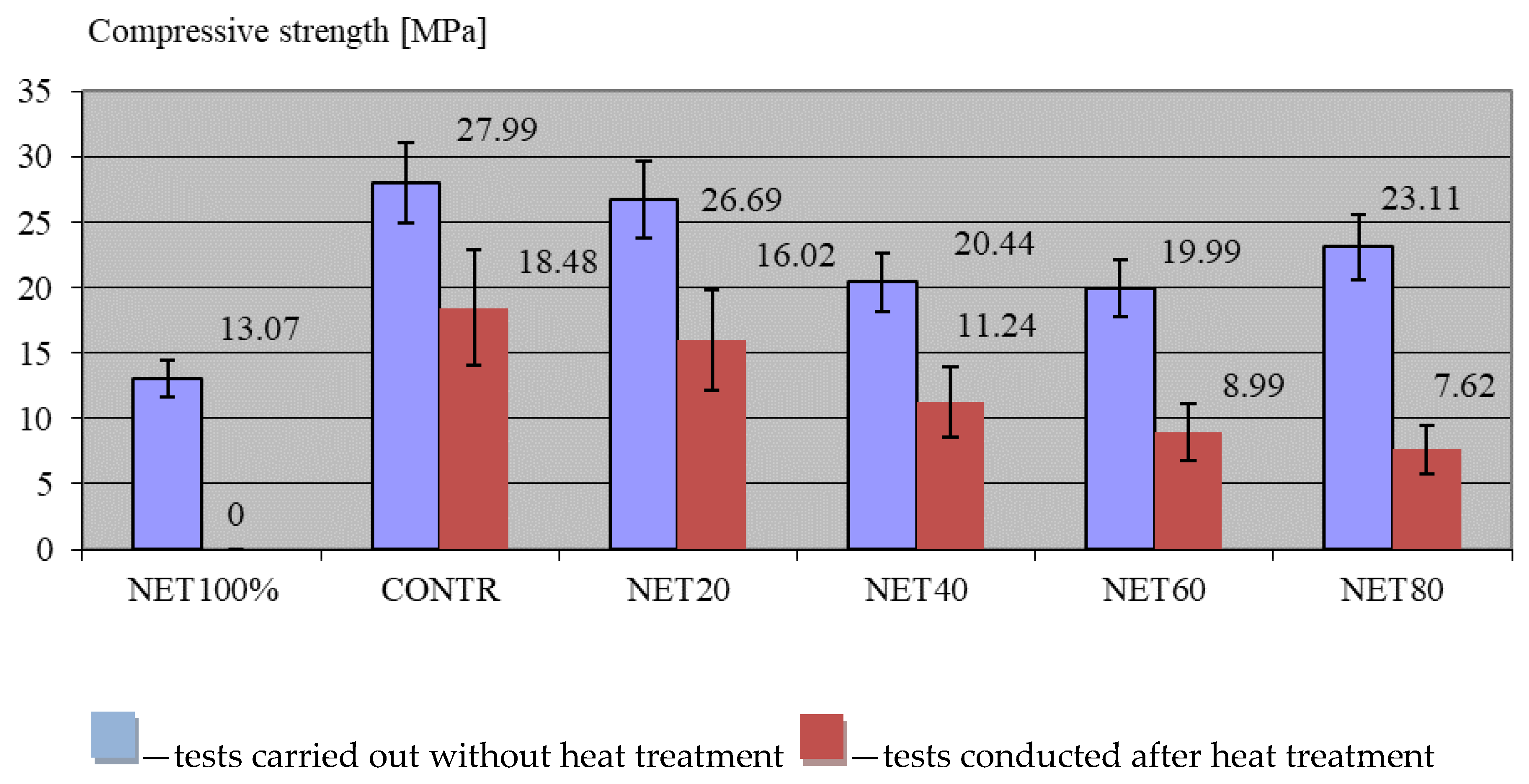
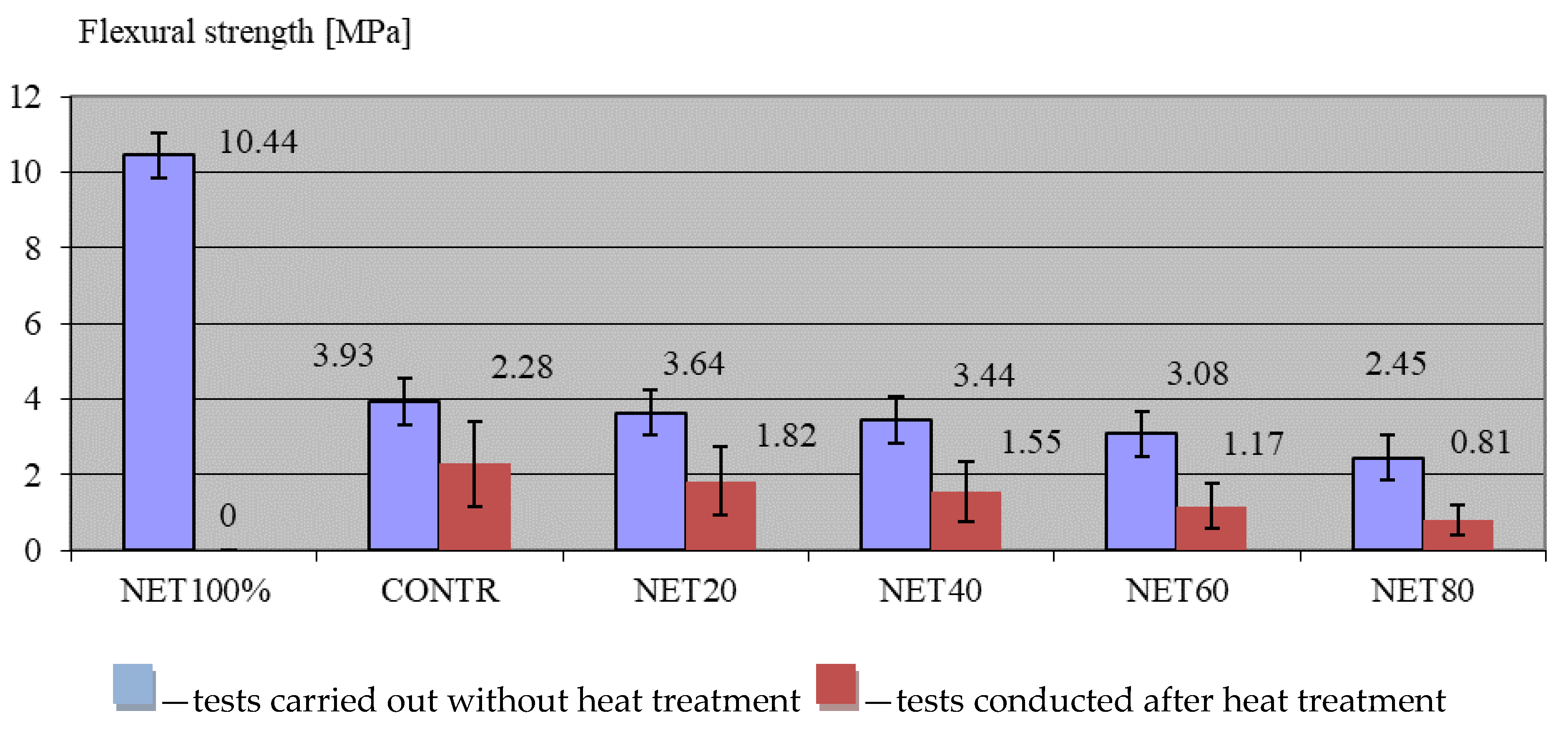

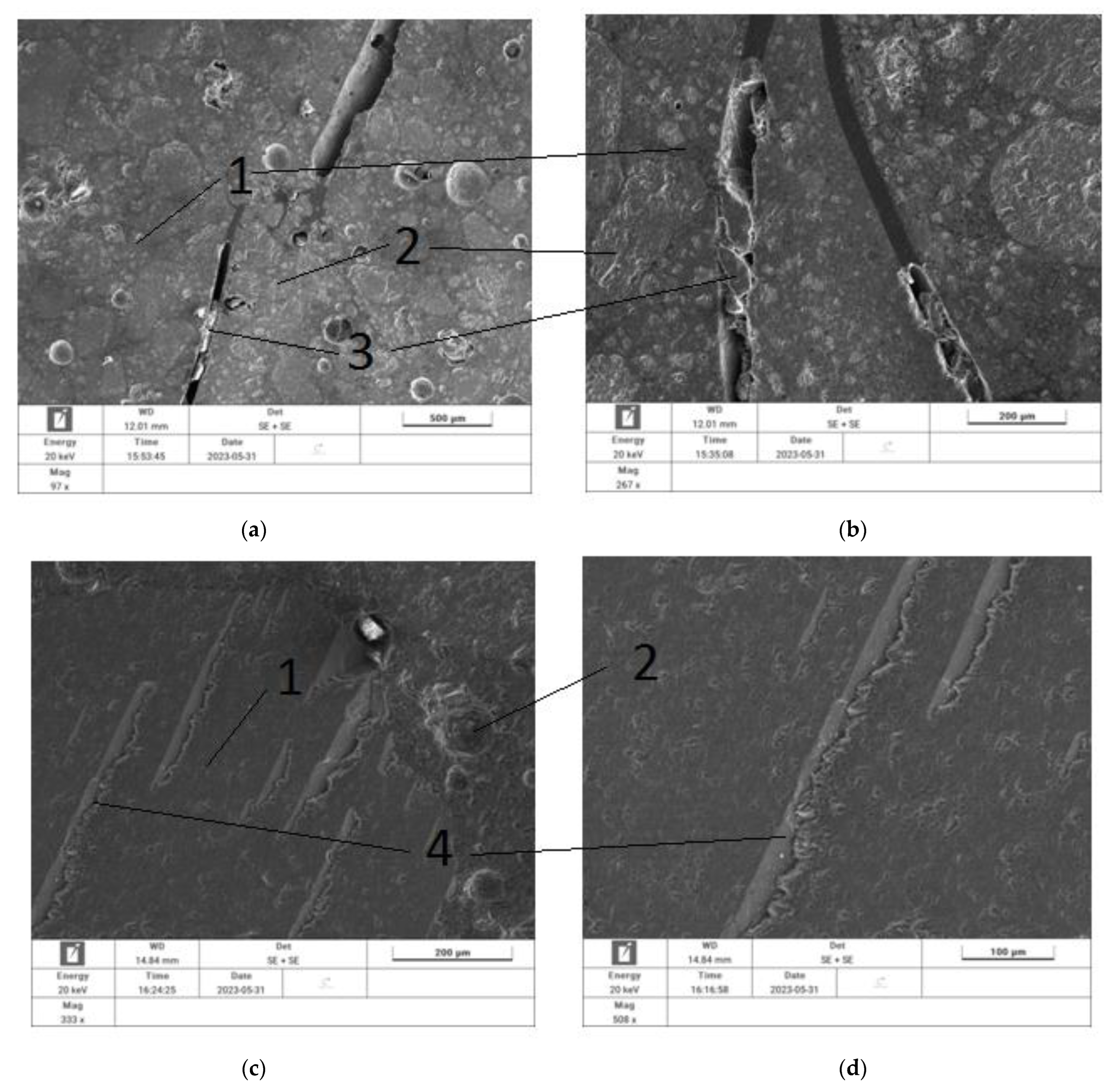
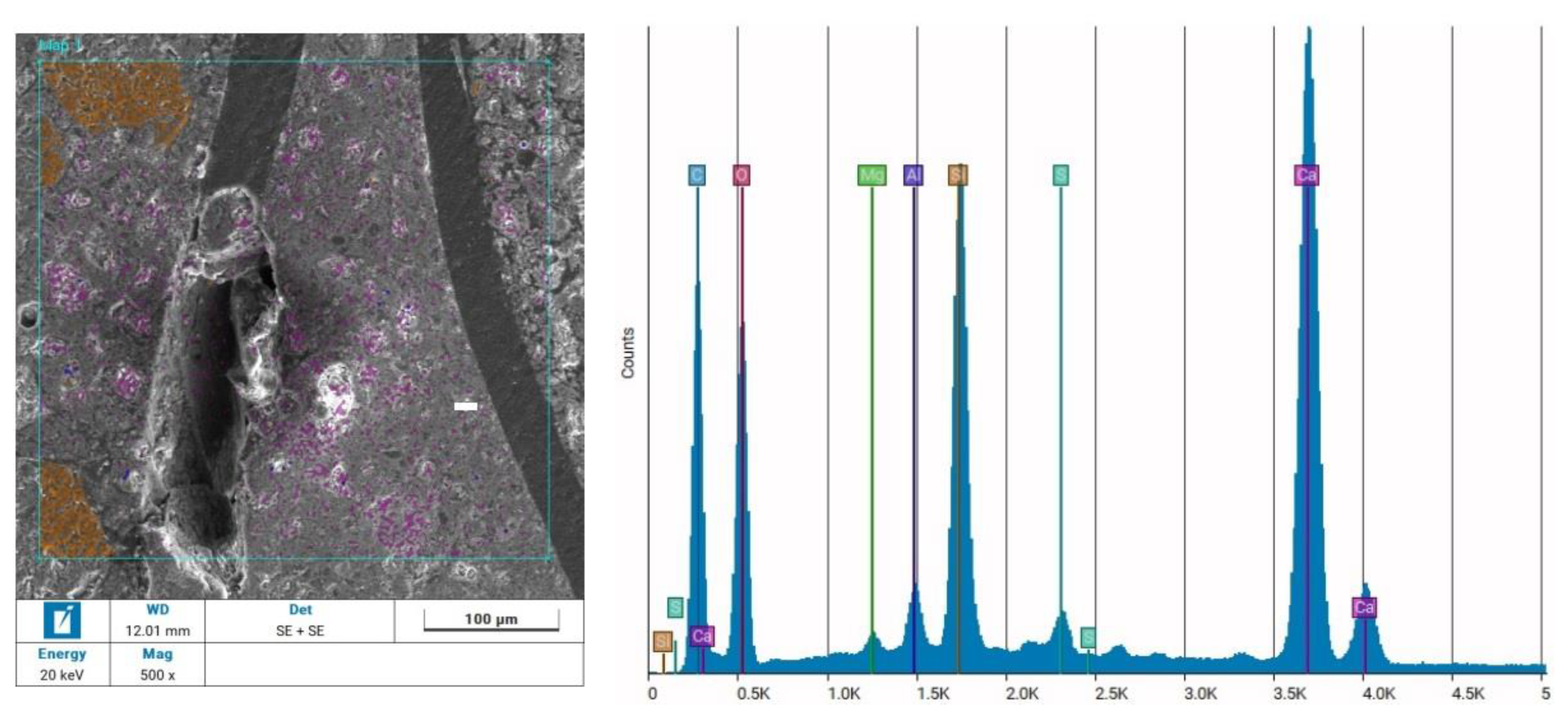
| Feature/Evaluation Method | Value |
|---|---|
| Chemical composition/PN-C-89280:1986 [116] | (C2 H4)n |
| Volumetric density/PN-EN ISO 1183-2:2006 [117] | 0.941–0.965 g/cm3 |
| Thermal conductivity/PN-EN ISO 1872-2:2008 [118] | 0.46–0.51 W/m- K |
| Tensile strength/PN-C-04243:197 [119] | 24.7 MPa |
| Relative elongation at yield stress/PN-EN ISO 1872-2:2008 [118] | >9.1% |
| Temperature resistance/PN-C-89280:1986 [120] | Above −50/below +80 |
| Feature/Evaluation Method | Unit | Average Score | Requirements |
|---|---|---|---|
| Initial setting time/EN 196-3:2009 [121] | min | 233 | >60 |
| Final setting time/EN 196-3:2009 [121] | min | 291 | |
| Water efficiency/EN 197-1:2012 [122] | % | 27.5 | |
| Constant volume/EN 197-1:2012 [122] | mm | 1.1 | <10 |
| Specific surface area/EN 196-6:2011 [123] | cm/g2 | 3688 | |
| Compressive strength: after 2 days/EN 197-1:2012 [122] | MPa | 23.9 | <10 |
| Compressive strength: after 28 days/EN 197-1:2012 [122] | MPa | 55.9 | 42.5–62.5 |
| Chemical analysis: SO3/EN 196-2:2006 [124] | % | 2.77 | <3.0 |
| Chemical analysis: Cl/EN 196-2:2006 [124] | % | 0.070 | <0.10 |
| Chemical analysis: Na2Oeq./EN 196-2:2006 [124] | % | 0.53 | <0.6 |
| Parameter | Unit | Value | Evaluation Method |
|---|---|---|---|
| Form | - | fine powder | Visual |
| Colour | - | grey | Visual |
| Fragrance | - | odourless | - |
| Density | g/cm3 | 2.05 | PN-EN 1097-6:2013-11 [125] |
| Bulk density | g/cm3 | 1.1 | PN-EN 1097-3:2000 [126] |
| Alkalinity | pH | less than 11.5 | PN-EN ISO 10523:2012 [127] |
| Property/Evaluation Method | Description |
|---|---|
| Form | Liquid |
| Chloride content/PN-EN 196-2:2006 [124] | <0.1% |
| Alkali content/PN-EN ISO 10523:2012 [127] | <2.0% |
| Compressive strength/PN-EN 197-1:2012 [122] | After 7 days, concrete tested ≥110% control concrete After 28 days, concrete tested ≥110% control concrete |
| Air content/PN-EN 934-2+A1:2012 [128] | Test mixture ≤ 2% by volume above the content in the mixture control |
| Water reduction earnings/PN-EN 934-2+A1:2012 [128] | In the test mixture ≥5% w compared to the control mixture |
| Density (20 °C):/PN-EN 1097-6:2013-11 [125] | 1.075 ± 0.02 kg/dm3 |
| pH:/PN-EN ISO 10523:2012 [127] | 5 ± 1 |
| Grain size/PN-EN 933-1:2000 [129] | 0.15 µm |
| Quantity of Substrate in kg Used for the Test Batch | Density Theoretical Substrate in kg/m3 | Volume in m3 of Trial Work | Conversion Factor per kg/m3 of Mixture | Mix Amount of Substrate in kg/m3 of Mixture | Density of the Substrate in kg/m3 | Component Volume in m3 | |
|---|---|---|---|---|---|---|---|
| Cement CEM I 42.5R CEMEX | 1.340 | 3100.00 | 0.000432 | 412.69 | 553.00 | 3100.00 | 0.1784 |
| Agricultural net fibres | 1.270 | 950.00 | 0.001337 | 412.69 | 524.12 | 950.00 | 0.5517 |
| Water | 0.595 | 1000.00 | 0.000595 | 412.69 | 245.55 | 1000.00 | 0.2456 |
| FAST-MIX | 0.030 | 1050.00 | 0.000029 | 412.69 | 12.38 | 1050.00 | 0.0118 |
| Microsilica | 0.067 | 2200.00 | 0.000030 | 412.69 | 27.65 | 2200.00 | 0.0126 |
| Total | 0.002423 | 136.70 | 1.0000 |
| Component | Quantity of Substrate in kg | Density of the Substrate in kg/m3 | Volume in m3 |
|---|---|---|---|
| Cement CEM I 42.5R CEMEX | 553.00 | 3100.00 | 0.178387 |
| Sand 0–2 mm | 48.00 | 2480.00 | 0.193548 |
| Gravel 2–4 mm | 960.00 | 2650.00 | 0.362264 |
| Water | 245.55 | 1000.00 | 0.245550 |
| FAST-MIX | 12.38 | 1050.00 | 0.011790 |
| Microsilica | 27.65 | 2200.00 | 0.012568 |
| Total | 2278.58 | 1.004108 |
| Component/Quantity in kg/m3 | NET100% | CONTR | NET20 | NET40 | NET60 | NET80 |
|---|---|---|---|---|---|---|
| Cement CEM I 42.5R CEMEX | 553.000 | 553.000 | 553.000 | 553.000 | 553.000 | 553.000 |
| Sand 0–2 mm | - | 480.00 | 480.00 | 480.00 | 480.00 | 480.00 |
| Gravel 2–4 mm | - | 960.00 | 960.00 | 960.00 | 960.00 | 960.00 |
| Water | 245.55 | 245.55 | 245.55 | 245.55 | 245.55 | 245.55 |
| FAST-MIX | 12.38 | 12.38 | 12.38 | 12.38 | 12.38 | 12.38 |
| Microsilica | 60.00 | 60.00 | 60.00 | 60.00 | 60.00 | 60.00 |
| Agricultural net fibres | 524.12 | - | 20.00 | 40.00 | 60.00 | 80.00 |
Disclaimer/Publisher’s Note: The statements, opinions and data contained in all publications are solely those of the individual author(s) and contributor(s) and not of MDPI and/or the editor(s). MDPI and/or the editor(s) disclaim responsibility for any injury to people or property resulting from any ideas, methods, instructions or products referred to in the content. |
© 2024 by the authors. Licensee MDPI, Basel, Switzerland. This article is an open access article distributed under the terms and conditions of the Creative Commons Attribution (CC BY) license (https://creativecommons.org/licenses/by/4.0/).
Share and Cite
Zegardło, B.; Maraveas, C.; Świeczka, K.; Bombik, A. Recycling Waste Agricultural Nets as Cement Composites. Materials 2024, 17, 1828. https://doi.org/10.3390/ma17081828
Zegardło B, Maraveas C, Świeczka K, Bombik A. Recycling Waste Agricultural Nets as Cement Composites. Materials. 2024; 17(8):1828. https://doi.org/10.3390/ma17081828
Chicago/Turabian StyleZegardło, Bartosz, Chrysanthos Maraveas, Kamil Świeczka, and Antoni Bombik. 2024. "Recycling Waste Agricultural Nets as Cement Composites" Materials 17, no. 8: 1828. https://doi.org/10.3390/ma17081828
APA StyleZegardło, B., Maraveas, C., Świeczka, K., & Bombik, A. (2024). Recycling Waste Agricultural Nets as Cement Composites. Materials, 17(8), 1828. https://doi.org/10.3390/ma17081828







